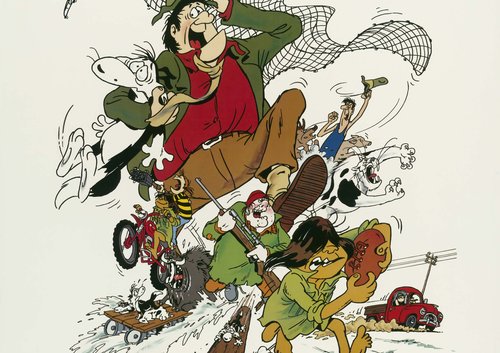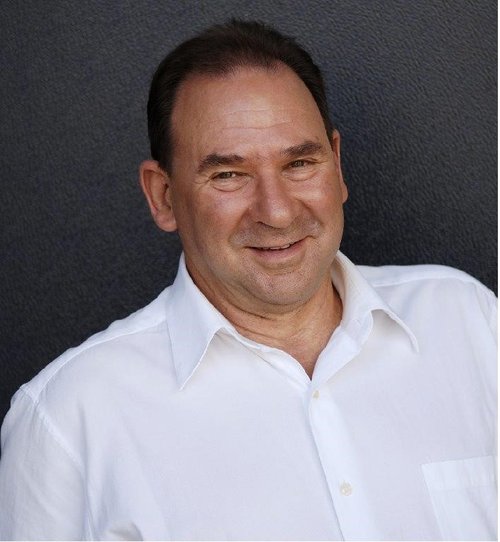
Wal meets Dog. Scene from Footrot Flats: The Dog’s Tale. Collection Ref. F7602.
Released in November 1986, Footrot Flats: The Dog’s Tale was a feature film adaptation of Murray Ball’s much loved Footrot Flats comic strip . It was the country’s first animated feature, and a wildly successful one at that – grossing around $2,500,000 at the domestic box office to become one of the most successful New Zealand films of the 1980s.
While the numbers were impressive, it is the endearing characters and depiction of an archetypal farming community in Footrot Flats which stole the hearts of New Zealanders throughout the motu. It would be a hard task to find anyone today who lived through the 80s and 90s and is not familiar with the lovable border-collie – aptly named Dog – and his good-humoured caretaker, Wal Footrot.

Footrot Flats: The Dog’s Tale promotional poster. Collection Ref. P01023.
Recently, we were fortunate to connect with John Barnett , who produced the landmark film alongside Pat Cox . John was kind enough to provide some personal reflections on the film, its successes, and the enduring legacy of Footrot Flats.
Below is our Q&A with John.

John Barnett.
Footrot Flats: The Dog’s Tale is one of New Zealand’s most successful and most watched films. What do you think was the secret to its success?
Footrot Flats, the cartoon strip, was enormously successful, and was a feature of most New Zealand newspapers. Independent News Ltd, which published the Dominion, Christchurch Press, the Manawatu Standard, the Timaru Herald, Waikato Times, and a number of other provincial papers, ran the strip on a daily basis. New Zealand audiences were very familiar with the characters and setting. Also, in the 70s — 80s, Footrot Flats reflected back to New Zealand an agrarian perspective which made people feel good.
In the 1960s, Rupert Murdoch’s News Ltd had bought a share in the Wellington Publishing Company (The Dominion), and they liked the strip, and began running it in News Ltd Australian papers as well. Adapting the strip to a movie meant that we were taking a popular, and much-loved environment, to an audience who were familiar with the content, and who were likely to go and see it.
Remember, at the time we only had two television channels in New Zealand. There were few foreign movies, and very few New Zealand movies, so we were going into somewhat uncharted territory, but we didn’t have to tell anybody what the film was about.
For the casting of the film, John Clarke as Wal was someone who everyone loved, and who an audience knew would give them a good laugh when they went to see the film.
Footrot Flats: The Dog's Tale was New Zealand’s first, and remains one of the country’s only, feature-length animated films. Why do you think that is?
At the time, animation was a very labour-intensive process and there was almost no digital production in this part of the world. There were some TV commercial production houses in New Zealand who specialised in animation, and they were very good, but their work to date had been of much shorter projects. We weren’t sure that we could actually produce 90 minutes of animated film here. Pat Cox, co-producer, had worked with Robbert Smit and knew that it would be possible to do the animation in Sydney, which we did.
Peter Jackson had not yet set up Wēta FX, and when you look at the work that comes from that studio now, there’s no question that animation is made here, and very successfully. Andrew Adamson (filmmaker and animator) had only just left school. These two Kiwis are giants of international animation content. I do think it would be more problematic to find a New Zealand subject which would transfer to animation, and attract a cinema audience in the same way, although we are seeing some exciting New Zealand animation content on TV. Also, I believe there are some films in development.
What drew you personally to the project? How did you get involved?
My belief in any film project is very much determined by two questions. Who is the audience? And how will you reach them? This project certainly answered those questions before we began.
Patrick Cox, who ran a successful television commercial production company, had initiated the idea and begun discussions with Murray Ball, and Patrick approached me to see if I would like to be involved. It took about a minute to make that decision!
I could see a project which would appeal to New Zealanders and Australians, and which would give people a good time when they went to the cinema. 37 years later it still makes people feel good.
The role of a film producer is not always easily defined – can you talk a bit about your involvement in the development of Footrot Flats: The Dog's Tale?
Personally, I think the role of the film producer is very easily defined.
Producers often come up with the idea for the film, or find material that will adapt to the screen, and it’s then their responsibility to ensure that the funding is organised and confirmed, that the right creatives are attached to the project, and that the finished work does what it set out to do – which is to attract an audience.
Pat Cox and I produced the film, and he had responsibility for the technical delivery of the material. The writers were very important, and Murray Ball as creator of the strip was a key component. It would have been impossible to make Footrot Flats without Murray’s involvement and creative approval of it all. Tom Scott came on to co-write the screenplay with Murray. Tom brought his experience in that area as well as his humour to the project. John Clarke provided Wal with all the personality and elements that an audience expected, and a lot more as well. He made Wal one of New Zealand’s quintessential cinema heroes.
So, in this case, as producer, putting all those elements together was part of my responsibility, and of course the financing was also in my wheelhouse. Independent Newspapers Ltd put up a good chunk of the budget, and in the mid-80s when top income tax rates were 66%, there were opportunities to invest in film and lower your tax burden. My friends at Fay Richwhite had a large client list who were attracted to the idea of investing in a project like Footrot Flats, and reducing their tax bills, so it was easier to raise the budget for this project than others which were looking for support.
I did approach the New Zealand Film Commission, which had been in existence for about eight years, [but they] would not support any approach for NZFC funding. So, one of New Zealand’s most successful films had no connection with the New Zealand Film Commission, which is regretful for everybody.
The last part of my role as producer of the film was to ensure that it was successfully marketed, and I oversaw the distribution of the film throughout New Zealand. It was a smash hit and was the biggest box office hit of the year, and I think is still in the Top 10 cinematic releases. The film has been released in a number of non-English speaking countries as well.
Another element which I took responsibility for as producer was the decision to hire Dave Dobbyn to write and perform the soundtrack, and then also the suggestion that Herbs perform with Dave on the iconic “Slice of Heaven” promotion.
What kind of cultural impact did this film have?
It would be hard to find any New Zealander over the age of 30 who hasn’t seen this film or wasn’t aware of the characters, or who can’t sing along to “Slice of Heaven”. Its portrayal of rural New Zealand did what all good stories do, which is show us what families and communities are like anywhere, told through the specific lens of that setting.
The actors who brought the roles to life included two of our best humourists, John Clarke and Billy T. James – sadly neither of them is with us today.
The music had a huge impact. Firstly, Dave brought an energy and creativity to the film, in a way which no New Zealand film had achieved. Even today it is still most probably the biggest selling soundtrack of any New Zealand film. “Slice of Heaven” was written specifically to be the background to the promotional trailer for the film.
When we recorded “Slice of Heaven”, we shot the trailer, which was performed in studio, and the response of everyone in that room was absolutely fantastic. I took the track to a number of the popular radio stations of the day, and several of them said to me “no one wants to see a bunch of Māori jumping round singing with Dave Dobbyn” – it was 1986! We released the trailer into cinemas and within a week or two every radio station in the country was playing the song, and the rest is history!
Dave Dobbyn with Herbs. “Slice of Heaven”. Collection Ref. F29192.
How is life in Aotearoa reflected in Murray Ball’s work?
I’ve mentioned that successful stories, books, films, and television shows us lives, situations and relationships which are familiar to all of us. But their specific setting brings credibility to these experiences and emotions.
I think every New Zealander would have known that Footrot Flats was set in rural New Zealand and portrayed an environment that most people were familiar with. As a country, we were transitioning from rural to urban. Our demographics were different 40 years ago. But again – picking up on the point that ‘all stories are universal’ – many people who saw the film in Australia, or who had read the cartoon strip in the Australian newspapers, thought that the farm was in Australia. And although the New Zealand that was portrayed was very much the New Zealand that Murray Ball lived and celebrated, it was understood and enjoyed by New Zealand’s population.
You have been involved with some of NZ’s most popular film and television. How does Footrot Flats: The Dog’s Tale fit into NZ film history?
I’m enormously proud of Footrot Flats, because it brought together such a diverse creative team. Its legacy is still alive nearly 40 years later, and it still gives joy to people of all ages. I think that today there wouldn’t be anybody who didn’t think that an animated work could be a New Zealand film. Many New Zealand films, including a number I’ve made, have looked to more dramatic or serious genres to tell their stories. But comedy does have enormous appeal. If one looks back at Goodbye Pork Pie, or 20 years before that, Don’t Let It Get You, or even three years after Footrot Flats, Peter Jackson’s Meet The Feebles, and then the enormous success of Taika Waititi’s comedies, I think all of these titles have entertained audiences here and around the world. They are an absolute cornerstone of New Zealand’s film history.